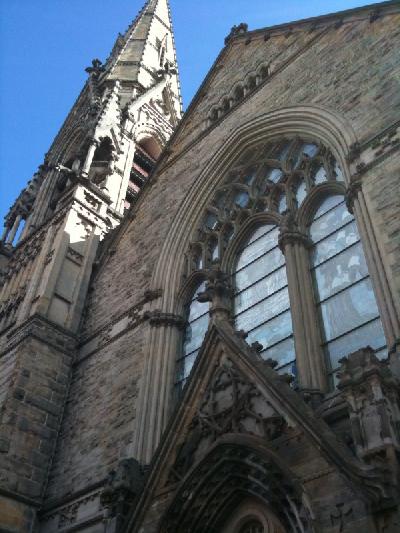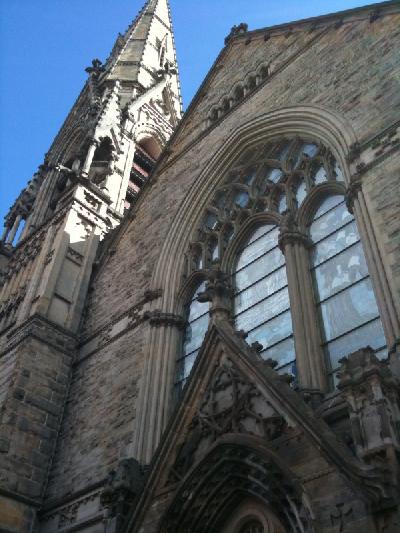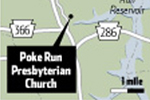
Category Archive: Religious Properties
-
Tens of thousands still powerless after storm
By Margaret Harding, Michael Hasch and Bill Vidonic
PITTSBURGH TRIBUNE-REVIEW
Thursday, September 23, 2010Thousands of Western Pennsylvanians remain without power today and might not have service restored until Sunday morning.
Wednesday’s brief but powerful thunderstorm has left a lasting impression.
Duquesne Light reported 13,000 customers — many in Allegheny County’s South Hills neighborhoods — do not have electricity. Customers in Baldwin, Castle Shannon, Dormont, Mt. Lebanon and Scott, as well as Banksville, Beechview and Brookline in the city, might not have service until Sunday, said spokesman Joseph Vallarian.
Allegheny Power reported 14,000 Pennsylvania customers were in the dark. Those in Allegheny, Washington and Westmoreland counties might not have service restored until 11:30 p.m. Friday, the company said.
High winds and lightning yesterday afternoon toppled trees, power lines and even an old church steeple, damaging homes, businesses and cars and prompting schools to cancel classes today. About 30 businesses and schools closed or delayed opening, according to WPXI-TV, the Tribune-Review’s news partner.
A generator leaking carbon monoxide forced the evacuation of a Mt. Lebanon apartment building early this morning, a spokeswoman with the township said. No one was injured.
Fourteen people who live in the lower levels of the building on Washington Road took refuge in the nearby municipal building, the spokeswoman said. Their apartments were ventilated, and residents returned about 7 a.m., she said.
Emergency dispatchers fielded calls of sparking electrical wires, downed trees and a transformer fire this morning in Pittsburgh.
Hilltop Road from Breckenridge Drive in Collier to Collier Avenue in Heidelberg was closed because of downed lines and trees, PennDOT said.
Wind gusts estimated at nearly 70 mph sent trees crashing onto cars in Mt. Lebanon and Banksville, according to National Weather Service reports and emergency dispatchers. Small hail was reported across the South Hills, the weather service said.
About 100,000 Duquesne Light and Allegheny Power customers lost power at the height of the storm.
Lightning shattered the steeple at a former South Side church housing the Pittsburgh Action Against Rape offices, sending the wooden, brick and copper structure through the roof and ceilings of the three-story building on South 19th Street.
“There’s a steeple on my chair,” said Leah Vallone, the center’s supervisor of crisis intervention, who escaped injury because she was in a meeting. “I was religious, but I think I will be even more so now.”
Five employees of the Lighting by Erik showroom on West Liberty Avenue in Dormont escaped injury when a window exploded under the force of the wind, shards of glass turning into shrapnel as dozens of chandeliers, lamps and glass accessories inside shattered.
“The windows were just shaking and rattling,” said Lewis Cantor, whose family has owned the business since 1965.
Westmoreland 911 dispatchers had reports of homes with structural damage, and downed trees and wires, said spokesman Dan Stevens. He said Greensburg, Unity, Penn and Murrysville as some of the hardest-hit areas.
“I was sitting there, watching the storm, and then all of a sudden the wind became so terrific, and this tree just cracked, and it fell straight in my yard. It missed my house, but it came close,” said Jack Zellie of Unity in Westmoreland County. “It happened suddenly. A great, big wind came up it seemed like a wind burst of sorts you could see (the tree) just crack. … It was overwhelming, to be honest with you.”
Damage reports continued to come in this morning, Stevens said.
“This was a fast-moving, widespread storm,” he said. “People made it home last night and just didn’t go back out.
“They’re just going out now and finding that there are trees down in their roads.”
Staff writers Cody Francis contributed to this report.
-
Two Schools Consolidate to Form Sister Thea Bowman Academy in Wilkinsburg
Thursday, September 30, 2010By Tina CalabroThe name of Sister Thea Bowman may not be widely recognized, but within the Catholic education community, she is celebrated for her commitment to the education of underprivileged children, especially those of African-American descent.
Sister Thea, a Mississippi native and granddaughter of a slave, converted to Catholicism at age 9 and later joined the Franciscan Sisters of Perpetual Adoration in Wisconsin.
As a scholar, speaker and performer, she presented as many as 100 inspirational talks per year before her death from breast cancer in 1990 at age 53. At the height of her ministry, she was interviewed on CBS’ “60 Minutes.”
Over the past two decades, a number of Catholic schools across the nation have been named in her honor. Now her legacy has become part of a newly consolidated Catholic elementary school in Wilkinsburg.
Sister Thea Bowman Academy, for pre-kindergarten through grade eight, replaces the former Holy Rosary elementary school in Homewood and the St. James elementary school in Wilkinsburg. The academy is in the former St. James building at 721 Rebecca St.
The diocesan committee that chose the name for the school was attracted to Sister Thea’s “charismatic and prayerful” approach, said the Rev. Kris Stubna, diocesan secretary for Catholic education.
“She is an excellent role model and inspiration for the school,” he said.
The consolidation of the schools became necessary because enrollment in each had declined to below 150, Father Stubna said. He added that declining enrollment in those schools reflects fewer school-age children in the city overall. The new academy has 300 students.
The consolidation decreases the cost of maintaining two buildings while enabling the new school to offer more programs, such as new science labs, he said.
The St. James building was chosen for use because it is the newer of the two and because students who live in Wilkinsburg do not have school bus transportation, but those who live in Pittsburgh do.
The decision to recast the school as an academy reflects its focus on “educational excellence and faith formation,” Father Stubna said.
The consolidated school, like the two schools it succeeds, is an initiative of the Extra Mile Foundation, which provides financial support to selected Catholic schools located in economically disadvantaged neighborhoods as well as scholarships to cover tuition.
The two other elementary schools supported by the foundation are slated for consolidation in the fall of 2011: St. Benedict the Moor in the Hill District and St. Agnes in West Oakland.
Father Stubna said the schools supported by the Extra Mile Foundation “give a choice for a quality program in an environment of faith.”
Michael and Yulanda Johnson of Lincoln-Lemington have four children at Sister Thea Bowman Academy in grades two, five, seven and eight. Last year, all four attended St. James.
Mr. Johnson said that combining school populations presents challenges, but “the staff is dedicated to making it go smoothly.”
Among the new features he appreciates in the facility are the science labs and brighter lighting. “The new labs are beautiful, an environment where kids are excited about learning,” he said.
He said he also is pleased about a strong turnout at parent meetings, the addition of two male teachers and upgrades to the school uniforms.
The Johnsons moved to Pittsburgh from Baltimore five years ago and soon decided to send their children to a Catholic school.
“We wanted them to be in a strong learning environment and have small class sizes,” Mr. Johnson said. Receiving help with the tuition cost also was a factor, he said.
Tuition at Sister Thea Bowman Academy is $1,800 for the first child in a family and $600 for the second. Additional children attend at no charge.
Like many families in schools supported by Extra Mile, the Johnsons are not members of a Catholic parish, but they say they are comfortable with the religious environment of the school.
Mr. Johnson, a customer service representative for Comcast, volunteers as a basketball coach at the school and noted that the consolidation has produced more interest in the team. The school is planning to add soccer and track teams.
“The larger enrollment has opened opportunities,” he said.
-
Between a Ramp and a Hard Place
Friday, September 10, 2010 11:33 AMWritten by Diana Nelson Jones
To some people, the historic standards that prohibit vinyl windows and metal awnings are dictatorial. To others, those standards safeguard authenticity and dumbing down is not an option.
When it’s your own budget, a little gray can seep into the argument.
Even someone who appreciates the high standards that are supposed to be followed in an historic district can sympathize with a building owner who needs to replace five 10-foot-tall windows in a group of Victorian row houses. Ouch.
But when you buy in an historic district you’re investing in more than a building.
The people of Calvary United Methodist Church in Allegheny West have been diligent in following the historic course. Their partner, the Allegheny Historic Preservation Society, helped them raise the more than $2 million needed for interior and exterior repairs in the late 1990s. That included removing some of the world’s largest Tiffany windows for cleaning and releading.
Visit their web site at www.calvarypgh.com.
They have raised about $180,000 for the next “must-do” project — making their fellowship hall in the basement accessible to the increasing numbers of people who use the church. They are anticipating six bids for a job that calls for an elevator, a new door carved into the side off the parking lot and a 30-foot ramp with an historically acceptable railing and ramp foundation. Which means limestone.
Based on the first bids to come in, Rev. Larry Homitsky tells me, the church is short somewhere between $75,000 and $120,000. The Historic Review Commission offered some flexibility on the railing but insisted on the limestone. Rev. Homitsky and the church’s architect will reappear before the HRC next month, maybe with hat in hand.
He said the church has had “tremendous support” over the years in grants and other gifts. Many people see Calvary as more than a church, in part because it is on the National Register of Historic Places and also because thousands of people a week, mostly from the community but not necessarily in the congregation, use it to practice yoga, square dance, learn art and confirm the day-at-a-time struggle against addiction. The Allegheny West Civic Council meets there the second Tuesday of every month. A lot of brides who want a beautiful church for their wedding pick Calvary instead of the one they go to. More than 1,000 Christmas house tourists converge on the church as a point of interest.
The time, effort and money spent in being an historic property is important, said Rev. Homitsky. That, set alongside the “ministry value” of functioning for people is the challenge.
If you want to help Calvary make their basement accessible and do it at historic standards, they will take donations. Specify on your check that it is meant for the ramp and elevator project and mail it to the church at 971 Beech Ave., Pittsburgh 15233.
-
Between a Ramp and a Hard Place
Friday, September 10, 2010 11:33 AMWritten by Diana Nelson Jones
To some people, the historic standards that prohibit vinyl windows and metal awnings are dictatorial. To others, those standards safeguard authenticity and dumbing down is not an option.
When it’s your own budget, a little gray can seep into the argument.
Even someone who appreciates the high standards that are supposed to be followed in an historic district can sympathize with a building owner who needs to replace five 10-foot-tall windows in a group of Victorian row houses. Ouch.
But when you buy in an historic district you’re investing in more than a building.
The people of Calvary United Methodist Church in Allegheny West have been diligent in following the historic course. Their partner, the Allegheny Historic Preservation Society, helped them raise the more than $2 million needed for interior and exterior repairs in the late 1990s. That included removing some of the world’s largest Tiffany windows for cleaning and releading.
Visit their web site at www.calvarypgh.com.
They have raised about $180,000 for the next “must-do” project — making their fellowship hall in the basement accessible to the increasing numbers of people who use the church. They are anticipating six bids for a job that calls for an elevator, a new door carved into the side off the parking lot and a 30-foot ramp with an historically acceptable railing and ramp foundation. Which means limestone.
Based on the first bids to come in, Rev. Larry Homitsky tells me, the church is short somewhere between $75,000 and $120,000. The Historic Review Commission offered some flexibility on the railing but insisted on the limestone. Rev. Homitsky and the church’s architect will reappear before the HRC next month, maybe with hat in hand.
He said the church has had “tremendous support” over the years in grants and other gifts. Many people see Calvary as more than a church, in part because it is on the National Register of Historic Places and also because thousands of people a week, mostly from the community but not necessarily in the congregation, use it to practice yoga, square dance, learn art and confirm the day-at-a-time struggle against addiction. The Allegheny West Civic Council meets there the second Tuesday of every month. A lot of brides who want a beautiful church for their wedding pick Calvary instead of the one they go to. More than 1,000 Christmas house tourists converge on the church as a point of interest.
The time, effort and money spent in being an historic property is important, said Rev. Homitsky. That, set alongside the “ministry value” of functioning for people is the challenge.
If you want to help Calvary make their basement accessible and do it at historic standards, they will take donations. Specify on your check that it is meant for the ramp and elevator project and mail it to the church at 971 Beech Ave., Pittsburgh 15233.
-
Poke Run Presbyterian Church Divided Over Historic Building
By Chuck Biedka, VALLEY NEWS DISPATCH
Friday, September 10, 2010
Last updated: 7:11 am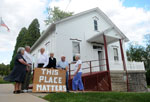
From left, Emma and Jim Dunmire, of Washington Township; Jack and Eleanor Zerbini, of Salem Township; Maynard Miller, of Kiski Township; and Kathy Moneymaker, of Washington Township, all gather together in front of the Academy Building located beside the Poke Run Church located in Washington Township on Thursday. Erica Hilliard/Valley News Dispatch
Nine members of Poke Run Presbyterian Church are asking Westmoreland County Court to side with history and preserve the church’s academy building and its contents.
The four couples and one individual filed a lawsuit Thursday to stop their congregation from demolishing the academy building and prevent the sale of antiques or other items inside.
Trustees insist that the congregation followed all congregational and Redstone Presbytery rules when it voted, 61-49, in June to demolish the wooden academy building, said trustee Vice President Walt Lange yesterday.
Trustee President Vince Goodiski said the congregation, organized in 1785, attracts 150 people to its two Sunday services. The church is located along Poke Run Church Road in Washington Township, across Route 66 from the intersection with Route 366.
Goodiski, a member since the 1980s, said the members voted to use the space to add an elevator and ground-floor access to the fellowship hall in the basement of the church.
The academy building has “no amenities, a crumbling foundation, musty smell,” and its metal roof recently sustained wind damage, he said.
Goodiski also said an older $10,000 ramp leading to the front of the church is inadequate and, at the back of the church, a $7,000 chair lift needs to be replaced to accommodate wheelchairs.
“It’s not feasible to fix the lift, and people who use the ramp and come into the church late are immediately seen by everyone else,” he said.
The nine members believe the handicap access is sufficient, and they want to have the building that opened in 1889 classified as a historic structure, member Maynard Miller said.
Both sides in the dispute retain deep emotional attachment to the church, even if they disagree about the fate of the academy building. Many have attended the church for decades.
Miller, whose name appears first on the lawsuit, said the academy served as the township’s first high school, starting in about 1919 and lasting about 10 years.
Miller said his wife, Martha, was baptized in the church, and she married him there in 1946.
James W. Dunmire is among those who are asking for an injunction.
“This is historic. We don’t want the building destroyed,” Dunmire said.
Goodski said the congregation has dealt with the issue for “at least five or six years” and this is “not something that came up as a last minute thing as they are trying to say.”
Goodski said they have offered the building to the nine “and anyone else to move it.”
One solution may be to “put the building on a slab” and move it elsewhere on the church property, he said, although that could be tricky because of the condition of the academy and its maintenance budget.
Goodiski could not say how much the church has spent on the building.
The church land includes the academy and church as well as an education building.
Goodiski and Lange believe the education building can be enlarged to handle community meetings, including those for the Kiski Valley Habitat for Humanity and Beaver Run Community 4-H Club.
He said the congregation wants to remove the building “so that we can better reach out into the community.”
The complaint includes a request for an injunction but a hearing on that hasn’t been scheduled.
-
Challenge Grant Generates $100,000 for Historic Religious Properties Program
PHLF News
Wednesday, August 04, 2010Thanks to $25,000 in challenge grants from two anonymous donors, The Pittsburgh History and Landmarks Foundation is reviving its recently troubled Historic Religious Properties Program, which provides matching grants to help congregations perform exterior maintenance on their facilities.
“Since 1997, we’ve been giving an average of 70 to 80 thousand dollars a year in grants. When we hit economic hard times in 2010, we suspended the grant program, because there just wasn’t enough money,” says Carole Malakoff, coordinator for the religious properties program.
With the grant program in limbo, two donors stepped up three weeks ago, giving the foundation 60 days to match the grants. The foundation’s President put up $12,500, and over 288 donors contributed gifts totaling $62,710, bringing the total grant package available for the 2011 grant cycle to over $100,210, making this the most successful annual appeal in the Pittsburgh History and Landmark Foundation’s 46 year history.
Applications for grants will be due by December 1, 2010, and provide matching grants up to $10,000 to Allegheny County churches that are over 50 years old.
“Over the years, the majority of our grants have gone to stained glass window work, roof and gutter repair, and masonry work,” says Malakoff.
As a result of the generous outpouring of support, PHLF has decided to host a technical assistance workshop on September 20 at the Calvary Episcopal Church in Shadyside. Experts will provide demonstrations to members of congregations on green building, handicap accessibility, and all that it entails to maintain a historic building.
“We sent out a letter in June to see if there was enough interest, and we’ve had 30 congregations call to say they are interested. So, we’ve had a wonderful response, and we’re still accepting people to come,” says Malakoff.
The workshops go from 10:30 a.m. to two p.m. Interested parties can contact Carole Malakoff at 412-321-3612.
Sign up to receive Pop City each week.
Source: Carole Malakoff, coordinator for PHLF Religious Properties Program
Writer: John Farley -
Historic Religious Properties Technical Assistance Workshop
August 1, 2010
PHLF NewsThanks to a successful Challenge Grant Initiative, the Pittsburgh History & Landmarks Foundation will be offering its Historic Religious Properties Grant Program again this Fall 2010.
We are offering a technical assistance workshop for congregation leaders, representatives, and guardians of historic religious structures on September 20 at Calvary Episcopal Church in Shadyside.
What Will the One-Day Workshop Be About?
You and others from your congregation will be able to attend seminars and speak with experts in the fields of historic preservation, building project planning and financing, and building construction and maintenance.
Seminar topics will include the following :
- Preserving historic religious properties;
- Prioritizing building needs and projects;
- Planning and organizing building projects;
- Financing a project and identifying grant and loan sources;
- Identifying and working with contractors, obtaining bids and estimates, and contracting the work;
- Repairing, restoring, and maintaining stained glass windows, masonry, roofs and gutters, domes, steeples, and steps; and
- Making your historic religious properties more energy efficient.
All of the topics that will be discussed will help you in planning and preparing your next PHLF Grant Application.
Historic Religious Properties Technical Assistance Workshop
- Date: September 20, 2010
- Time: 8:30 a.m. to 2:00 p.m.
- Location: Calvary Episcopal Church, 315 Shady Avenue, Pittsburgh, PA
- Fee: $50.00, payable to PHLF.
Fee covers up to 3 attendees from your congregation, including box lunches.
(Please mail your check by September 15 to Carole Malakoff, PHLF, 100 W. Station Square Drive, Suite 450, Pittsburgh, PA 15219)For reservations contact: hrp@phlf.org or Carole Malakoff: 412-471-5808 or 412-321-3612.
Attendance is limited.
-
Foundation Offering Money to Help Churches Pay For Repairs
By Jodi Weigand
PITTSBURGH TRIBUNE-REVIEW
Monday, July 26, 2010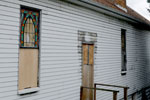
Stained-glass windows at First Baptist Church of Glassport were vandalized Thursday. The church hopes to obtain help from the Pittsburgh History & Landmarks Foundation's Historic Religious Properties Program to make repairs. Jasmine Goldband | Pittsburgh Tribune-Review
A small Glassport church might have to pay thousands of dollars to replace antique stained-glass windows broken by vandals.
“They were all handmade,” said the Rev. Ira Kelly, co-pastor of First Baptist Church of Glassport. “They’re as old as the church is, and now they’re lying here on the floor in pieces.”
In addition to the heartbreak of losing the four 100-year-old windows in the sanctuary late last week, the congregation is suffering sticker shock. Replacements could cost as much as $12,000, Kelly said. That’s a tall sum for the 25-member church, he said.
In a twist of fate, the vandals hit shortly after the Pittsburgh History & Landmarks Foundation announced the revitalization of a program that could help the congregation pay for the damage. After two years of struggling to fund its Historic Religious Properties Program, the foundation said, an influx of donations has helped raise more than $100,000 for grants to assist churches in paying for renovations.
“We all felt it was an overwhelming response from our contributors,” said Carole Malakoff, coordinator for the foundation’s religious properties fund. “We were really thrilled at how this (fund drive) turned out.”
Due to a lack of money, the foundation had not awarded any religious property grants this year and gave just $32,000 in 2009, she said. Typically, the fund yielded about $75,000 a year in grants.
The recent fundraising push began three months after the foundation’s annual appeal netted just $22,000. Two members offered a $25,000 challenge grant, to which the foundation added a challenge grant of $12,500. The campaign ended last week with 288 gifts totaling $62,710.
Churches in Allegheny County that are more than 50 years old can apply for a grant of up to $10,000 to be disbursed in 2011. It’s a matching grant, meaning that if a church gets $5,000, the congregation must raise $5,000 to match it.
Malakoff said she has fielded calls from numerous church leaders seeking money to repair gutters and roofs damaged in February’s record snowfall. The foundation gets about 35 formal applications a year from churches seeking grants.
This year, the foundation has limited the scope of work to exterior renovations, including stained-glass windows, roofs, gutters and masonry work, Malakoff said.
“Those are big issues with historic properties,” she said.
Since 1997, the foundation has awarded about $700,000 in grants, which resulted in about $2.4 million in work on 100 historic religious buildings. Many churches raise money above and beyond the required matching funds, Malakoff said.
The foundation wants to keep the tradition going by establishing an endowment for permanent funding of the religious properties program, she said.
“We look at them as the major cornerstone of a community,” Malakoff said. “Many of these buildings are used for all kinds of community outreach programs. They’re of utmost importance to the community.”
On the WebApplications for grants through the Pittsburgh History & Landmarks Foundation’s Historic Religious Properties Program are available online at phlf.org.
For details about a September technical assistance workshop for churches planning renovations, e-mail Carole Malakoff at hrp@phlf.org.

